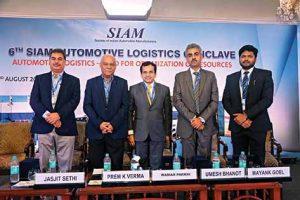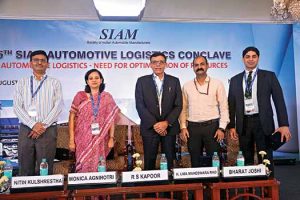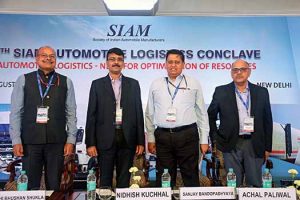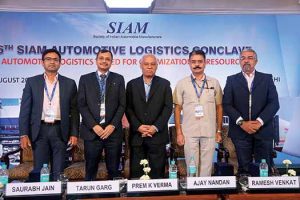The sixth SIAM Logistics Conclave highlighted various opportunities and the need to innovate.
Story by:
Anwesh Koley
The Society of Indian Automobile Manufacturers (SIAM) held its sixth SIAM Automotive Logistics Conclave for two days in New Delhi recently. Themed ‘Automotive Logistics – Need for Optimisation of Resources’, the event highlighted various opportunities for multi-modal transportation along with innovations that will lead to higher efficiency and agility in the automotive logistics space. Expressed Prem K Verma, Chairman, SIAM Logistics Group and Project Leader – Distribution & Logistics Strategy – Tata Motors, that a better understanding of automotive logistics is necessary. “To understand the requirements there is a need to facilitate need-based interactions,” he mentioned. Touching on the auto industry’s progress towards contributing 12 per cent of India’s GDP as part of the Automotive Mission Plan (2016-26), Verma averred, “The cost of logistics in India is high. It is especially the case in automotive logistics where 96 per cent of the cargo moves on roads. To cut costs, there is a need to eliminate wastage.” He also said that to promote multi-modal transportation model, cost-competitive development of adequate infrastructure is essential.
Stating that railways and roads constitute a heavily loaded network for transportation of freight, K Uma Maheshwar Rao, IRS, Joint General Manager, Dedicated Freight Corridor Corporation of India Ltd., said that they are constructing the Eastern Dedicated Freight Corridor and Western Dedicated Freight Corridor. The Eastern Dedicated Freight Corridor will run from Ludhiana, Punjab, to Dankuni, West Bengal, he informed. The plan is to transport goods at an average speed of 75 kmph, reducing the turn-around time. Stating that a rake loaded in Mumbai in the morning will reach Dadri the same day or next morning, Rao averred, “This will contribute to the silent revolution in logistics that is underway in the country.” He indicated that with the arrival of dedicated freight corridors like the Delhi Mumbai Industrial Corridor (DMICDC), the Amritsar Delhi Kolkata Industrial Corridor (ADKIC) and other freight terminals, after 10 years, a lot of seamless integration of Indian railways is expected.
Pointing at the need for efficient logistics channels and for them to be successful, N Sivasailam, Special Secretary, Department of Logistics, Ministry of Commerce, Govt of India said, “It is time we start prioritising freight, for which I have also requested a policy shift. We need a system to track cargo shipments, by having improved timetables to monitor the incoming and outgoing of the ships. We also need to work closely with the railway ministry to make the operations profitable for licenses.” Deliberating on logistics and supply-chain management at connected platforms as a way to bring inefficiency, a speaker at the conclave stressed upon tracking solutions to provide the goods in a supply chain on a real-time basis using tools like IoT, GPS, and advanced software. Another speaker, touching upon railway and road connectivity, stressed on creation of port facilities to ensure smooth logistics flow. He gave an example of the inland port at Pandu, which has railway and road connectivity in addition to a port facility. Such an infrastructure will provide immense opportunities for the development of the auto industry, he averred.
Stating that employment opportunities will increase with an increase in logistical efficiency, a speaker drew attention to in-land waterways. The Brahmaputra, he said, is more than 900 km long, and offers much scope to provide logistic solutions for the movement of goods across domestic and international channels. Umesh Bhanot, MD, APL Logistics Vascor Automotive Pvt Ltd., said in his presentation that it is important to recognise the various dimensions when talking about optimising outbound logistics like finished vehicles and aftermarket parts. Parameters of optimisation, as defined by OEMs, are quality of processes, cost, delivery, and environmental impact, he added. Stating that the options available are roads (suited for short routes), rail (suited for long hauls), coastal shipping (for coast to coast movement) and a function of ocean freight for export to achieve the most efficiency, Bhanot expressed that OEMs are experimenting with various distribution models for stockyard optimisation. “Intermodal rail is a viable transport mode to manage a service-sensitive, lean inventory of auto-parts supply chain,” he opined. Highlighting the importance of collaboration of all stakeholders, Jasjit Sethi, CEO, TCI Supply Chain Solutions, asserted, “For optimising outbound logistics, we should consider LoT size (sell few, buy few), order replenishment, mint condition, cost of logistics, network design, medium to long term plans, and carrier optimisation. “The only way to win is by working together and respecting the ecosystem,” he added.
Providing an insight into how innovation can lead to an improvement in logistics efficiency, D K Rai, Director, Chep India, said, “We need to deploy small but innovative practices to dial optimism. Adhering to standardisation, identifying opportunities to collaborate and prioritising sustainability are the steps to go about it. The starting point can be making the inbound supply chain more efficient by introducing the systemisation of packaging.” A speaker mentioned, for an increase in automation there was a need for a robust autonomous supply-chain that focused on visibility, predictive analytics, prescriptive and finally, self-learning technology. Averred another panelist that logistics costs have to come down in proportion to a rise in efficiency. Stating that the current logistics costs are much higher than in other parts of the world, he explained that an efficient multi-modal transportation can address this and many other challenges that currently lie in front of the industry and its stakeholders.























